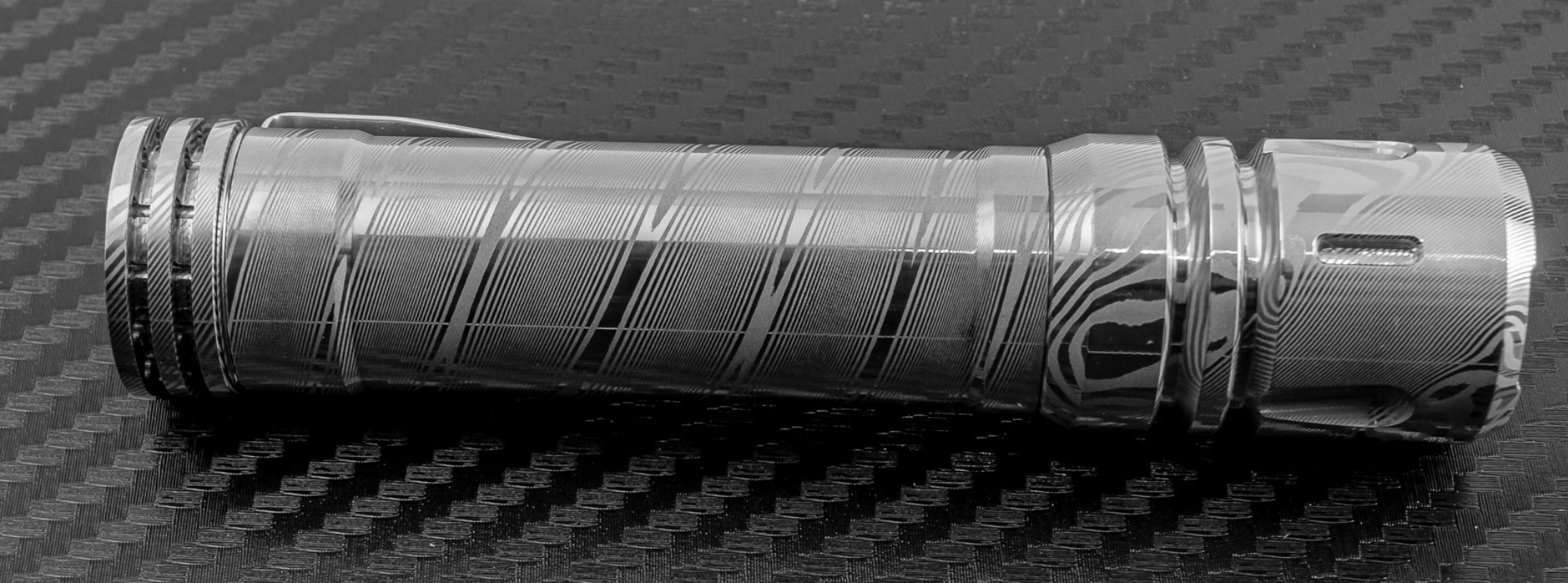Lumintop asked me if I wanted to review a series of flashlights for them so I said yes. Over the coming weeks I will be posting my written and video reviews with a few photos.
The construction and fit and finish of this light is impressive. The front emitter and tail are both made of brass. The light comes vacuum packaged to keep the brass in a pristine shiny state. As soon as you open it, the brass will start to oxidize and distress. I found this to be a fast process, within a few days your light will start to take on a lot of character. You can always seal the metal first thing to preserve the shiny look or use a metal polish to “restore it”
The center tube is internally made of copper for heat dissipation, with the outside having a carbon fiber weave with what looks like a few brass wires in it to set the look off from normal carbon fiber. This middle section is the best place to hold on to the light when it starts to get hot from continual use on high. The end cap is brass as well and holds the tail click button. I will talk more about that below. The light is IPX-8 rated for about 6 feet. With a battery installed this isn’t a lightweight light, it’s a very solid somewhat heavy but it’s a powerful tool too. Mine with the included battery weighed in at 5.7 oz.


The light quality is good. This light uses a Cree XM-L2 U2 LED Chip and I would call it a neutral color. The light on high mode produces 1000 lumens and will run for a quoted 2.5 hours. I think this is pretty accurate as the brightness compares to my other 1000 lumen lights. On medium it produces 170 lumens at 11 hours, and on low 25 lumens for 65 hours. The light has a glass lens that has double antireflective coating on it, with an o’ring to seal it to the body. The reflector is mirror like and smooth. The LED itself has a lens over it too. I would call this light between a thrower and a flood. It has a narrow angle reflector but the beam spreads pretty easily.
The head (brass) really does get very hot on high. I would guess north of 130F after about 10 minutes of high use. The carbon fiber parts and the rear stay cool enough to touch. On the lower light outputs, the heat output are not a problem. It might be a good idea for Lumintop to put in a thermal controls to dim the light if it gets over a level where the outside could burn you.
This light is turned on with a large button in the tail cap. The button is flat and made of metal a milled aluminum it looks like. It has the lumintop logo on it and it spins freely. The switch feels pretty good but has a little side to side play. The switch can either be On or Off and used in ½ presses to change modes. I do like that it’s flush as this light will tail stand. The light has only 3 modes as I covered above, a high, medium, and low mode. No special flashing etc. There is also no memory modes.
This light has a slim long “Deep carry” style clip. It really is tight to the body of the light and makes the light very secure in your pocket or its included pouch. On my brass model light it’s made of a polished stainless steel. It uses torx screws to attach to only one point of the body of the light. It is removable.
The Lumintop Prince comes with a nice full grain leather case. The light fits tightly in it with the pocket clip to one side. It also has a belt clip. It’s a nice upgrade over a typical nylon “tactical style” holder. The leather makes sense for a classy light. The case has a spot on one side for a spare 18650 battery as well which is nice.

The light came with a Lumintop 18650 lithium ion battery that’s 3600mah but did not include a charger. This battery says it’s one of the popular NCR18650B models made by Panasonic. I have no way of verifying that it is actually a Panasonic battery. When I got it, it came at about 3.7v. I charged it in my Nitecore D2i charger at 500ma and it was full 5 hours later before it read 4.2v (Full). I have a charger that prioritizes safety over speed and I am ok with that. Never leave your lithium ion batteries unattended when charging. Safety first. The battery life has been great with this cell, no trouble at all with it so I would say it’s probably a real Panasonic cell because of it’s high quality.

The materials of this light set it apart and make it a luxury light. It’s non tactical and probably fits most people in most situations better than a tactical light. This would make a great gift for someone if combined with a nice, safe, lithium battery charger (Assuming they didn’t have one). I like the light and have been using it a lot. For it’s size it’s performance is great, the heat is a bit of a concern if used on high for a long time but that’s to be expected for such a high lumen light. Overall I recommend it.
If you are interested in purchasing this light, please click my Amazon link. http://amzn.to/1V9X50I
Lumintop has offered me a 20% off discount code for my fans by using the code PZKZTJFB
Make sure the seller is “LUMINTOP DIRECT” to make sure the code works to get your 20% discount on all Lumintop products. The code is valid through 12/31/2016
To see the entire store where the discount is valid https://goo.gl/UkmNlN


